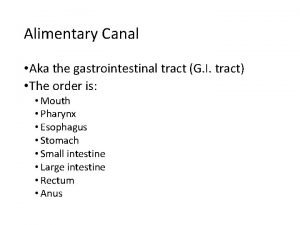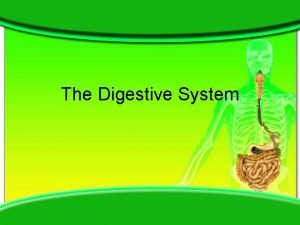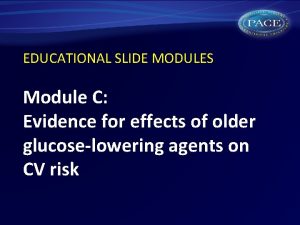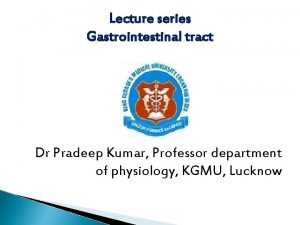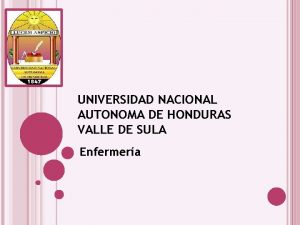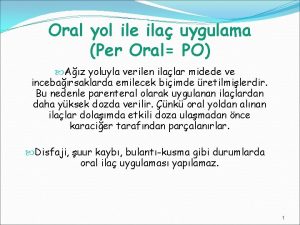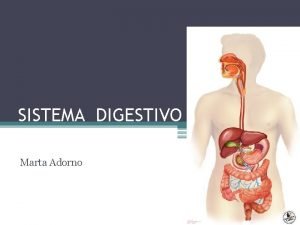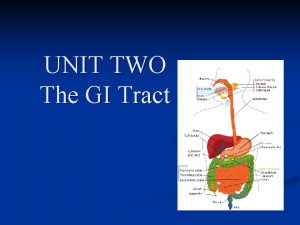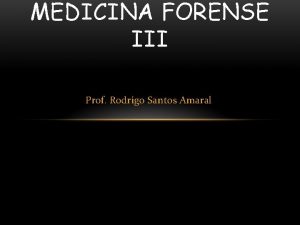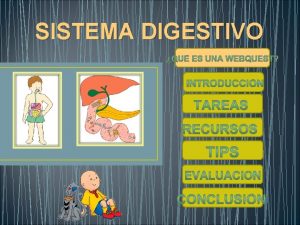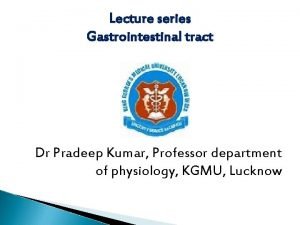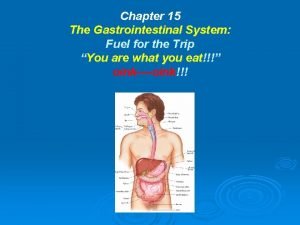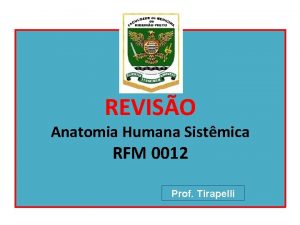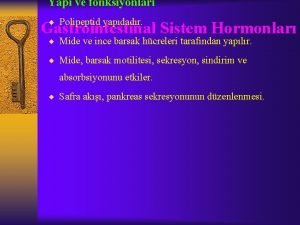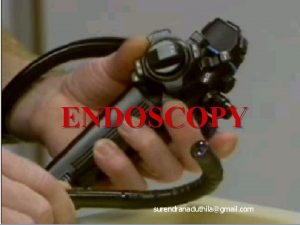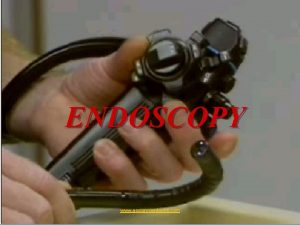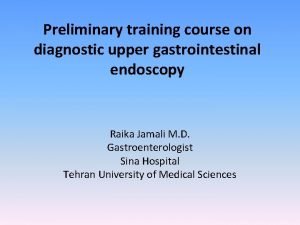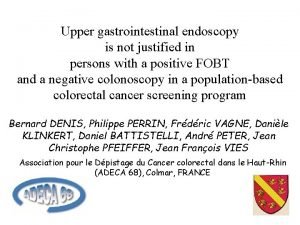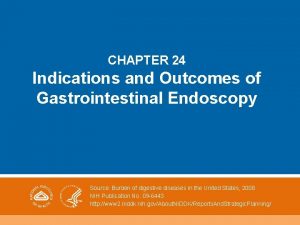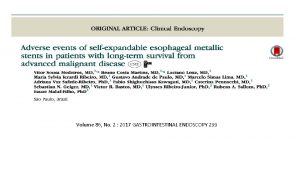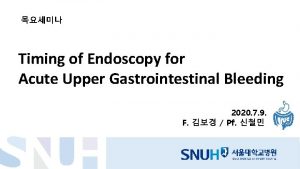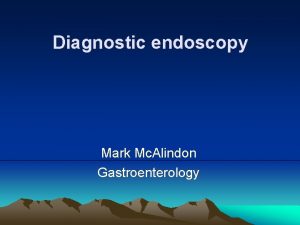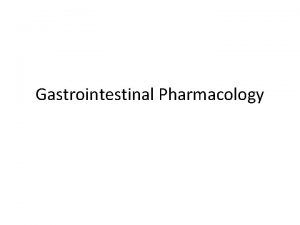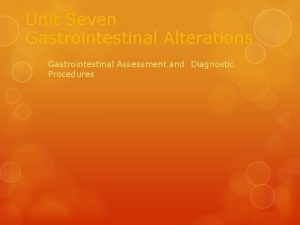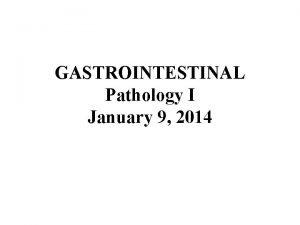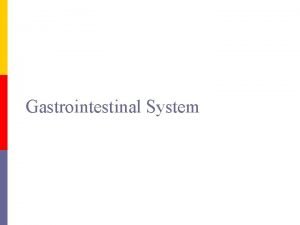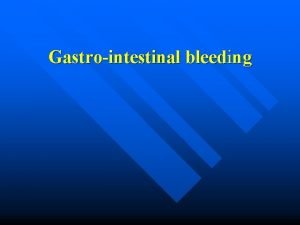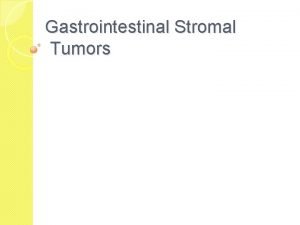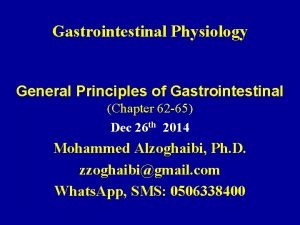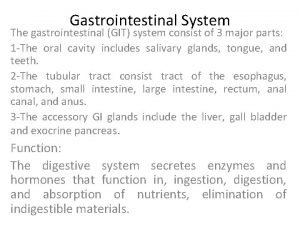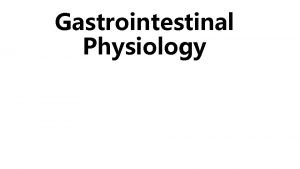Gastrointestinal Endoscopy Endoscopy Traditionally performed only on a























- Slides: 23

Gastrointestinal Endoscopy

Endoscopy • Traditionally performed only on a referral basis • Many private practices are starting to invest in equipment • Technicians assist with patient prep, during the procedure, take care of equipment

Required functions • 4 way deflection • Air/water/suction capabilities • Optics/visualization – Video endoscopes • Tube length • Large biopsy channel

Endoscope anatomy • Insertion tube – 100 cm or longer – Contains insufflation and water channel – Second suction/biopsy channel – Distal tip moves in all 4 directions

Endoscope anatomy • Handpiece – Eyepiece – Deflection knobs – Air/water valve – Suction valve – Separate channel for instrument insertion

Endoscopy anatomy • Umbilical cord – Conveys light from external source into fiberoptics of insertion tube

Video endoscopy • Attach specialized camera to eyepiece • Video endoscope

Forceps Biopsy ◦ Outer diameter is slightly smaller than biopsy channel diameter ◦ 50 cm longer than channel Retrieval forceps ◦ Single loop snare ◦ 3 or 4 prong grasper ◦ Basket retrieval Cytology brushes Aspiration catheters Balloon dilators

Endoscopy • Esophagogastroduodenoscopy (EGD) – Performed in patients with chronic vomiting, suspect FB, suspect GI ulcers, strictures and for collecting biopsy specimens • Colonoscopy – Often used when tumors are suspected, chronic diarrhea

Endoscopy • EGD’s and colonoscopies are performed primarily with a flexible endoscope vs. rigid endoscope

Endoscopy • Patient Prep – Area to be examined must be emptied hours before the procedure

Endoscopy • EGD – Esophagus, stomach, duodenum – Patient comes to clinic 24 hours prior to procedure – Withhold food for 12 to 24 hours – Withhold water for 4 hours – If GI motility is compromised, you may need to repeat later

Endoscopy • Colonoscopy – Patient arrives at clinic 2 days before the procedure – Fast for 24 to 36 hours – Administer osmotic cathartic the day before via a stomach tube • Go. LYTELY – Administer again (twice) the afternoon before the procedure 2 hours apart, the last dose 2 -4 hours before the procedure starts. – Warm water enema 1 hour prior to procedure

Endoscopy • After anesthesia induction – Colonoscopy – EGD • Watch for over-filling of the stomach with air as this will cause difficulty in respiration

Endoscopy • Technicians often are in charge of moving the endoscope in and out of the body for the veterinarian, and controlling knobs and valves • Micromovements are crucial • Allows the vet to focus on the procedure

Endoscopy • Obtaining biopsy samples – Have biopsy instruments ready at all times – Check forceps for working condition prior to procedure – Be sure you know the forceps work prior to the procedure – Communication

• Handling biopsy. Endoscopy samples – Specimens are small • thickness – Tease sample out of forceps gently with a 25 G needle – Shake sample into preservative vial directly or onto tissue paper and then into vial

Endoscopy • Cleaning the endoscope – Very important as the endoscope can become inoperable if improperly maintained – Consult the manufacturer’s manual

Endoscopy • Cleaning the endoscope – Initial cleaning is very important. – Flush water then air through the air/water channel – Wipe insertion tube with a soft cloth – Suction detergent/flush water through insertion tube – Brush channels of the endoscope – Clean and lubricate valves

Endoscopy • Cold sterilization – Allow appropriate contact time – Rinse – Hang to dry

Endoscopy • Storage – Hanging position – Well ventilated cabinet – Do not store in the padded case

Other uses • • • PEG tube placement Cystoscopy Rhinoscopy Bronchoscopy Equine – EIPH – Laryngeal paralysis – “roarers” • Arthroscopic procedures

Endoscopy • Purchasing an endoscope – Last 5 -10 years – Buy quality unit – Human pediatric scope can be used, but may need an adult scope for larger dogs
 Gastrointestinal tract
Gastrointestinal tract Pathophysiology of intestinal obstruction
Pathophysiology of intestinal obstruction Gastrointestinal hormones
Gastrointestinal hormones Conistipation
Conistipation Gastrointestinal medical terminology breakdown
Gastrointestinal medical terminology breakdown Why does metformin cause gastrointestinal problems
Why does metformin cause gastrointestinal problems Gastrointestinal tract
Gastrointestinal tract Motilidad gastrointestinal
Motilidad gastrointestinal Malrotasi traktus gastrointestinal
Malrotasi traktus gastrointestinal Sublingual ilaç uygulama
Sublingual ilaç uygulama Nutrition focused physical assessment
Nutrition focused physical assessment Which is not part of the alimentary canal
Which is not part of the alimentary canal Emt chapter 18 gastrointestinal and urologic emergencies
Emt chapter 18 gastrointestinal and urologic emergencies Peritônio
Peritônio Dumping syndrome signs
Dumping syndrome signs Sinal de lichtenberg medicina legal
Sinal de lichtenberg medicina legal Embriologia del sistema gastrointestinal
Embriologia del sistema gastrointestinal Intestinal villus
Intestinal villus Embryo folding
Embryo folding Hirschsprung disease nursing management
Hirschsprung disease nursing management Chapter 15 the gastrointestinal system
Chapter 15 the gastrointestinal system Anatomia rim
Anatomia rim Gastrik inhibitör polipeptid
Gastrik inhibitör polipeptid Gastrointestinal tract
Gastrointestinal tract
